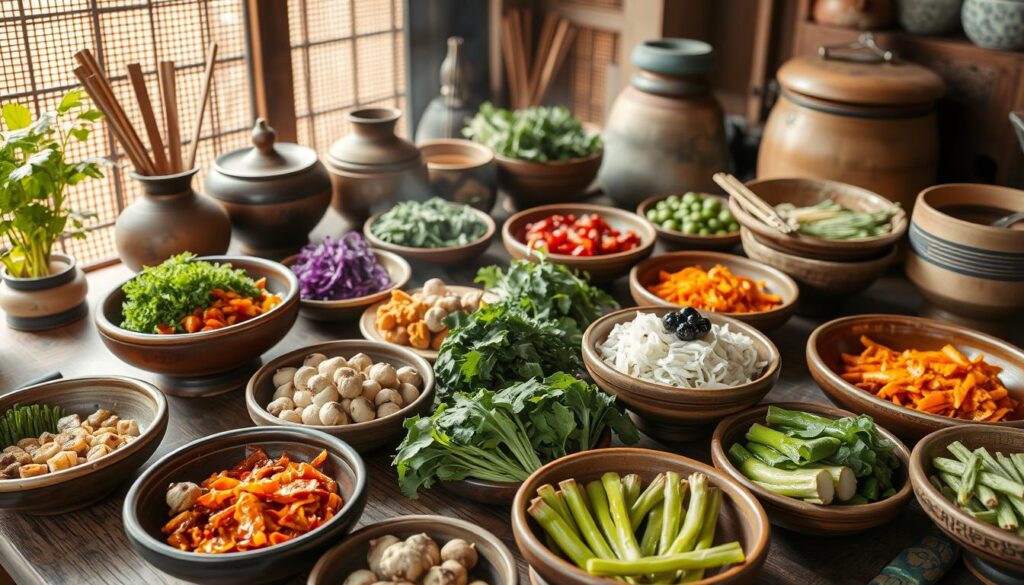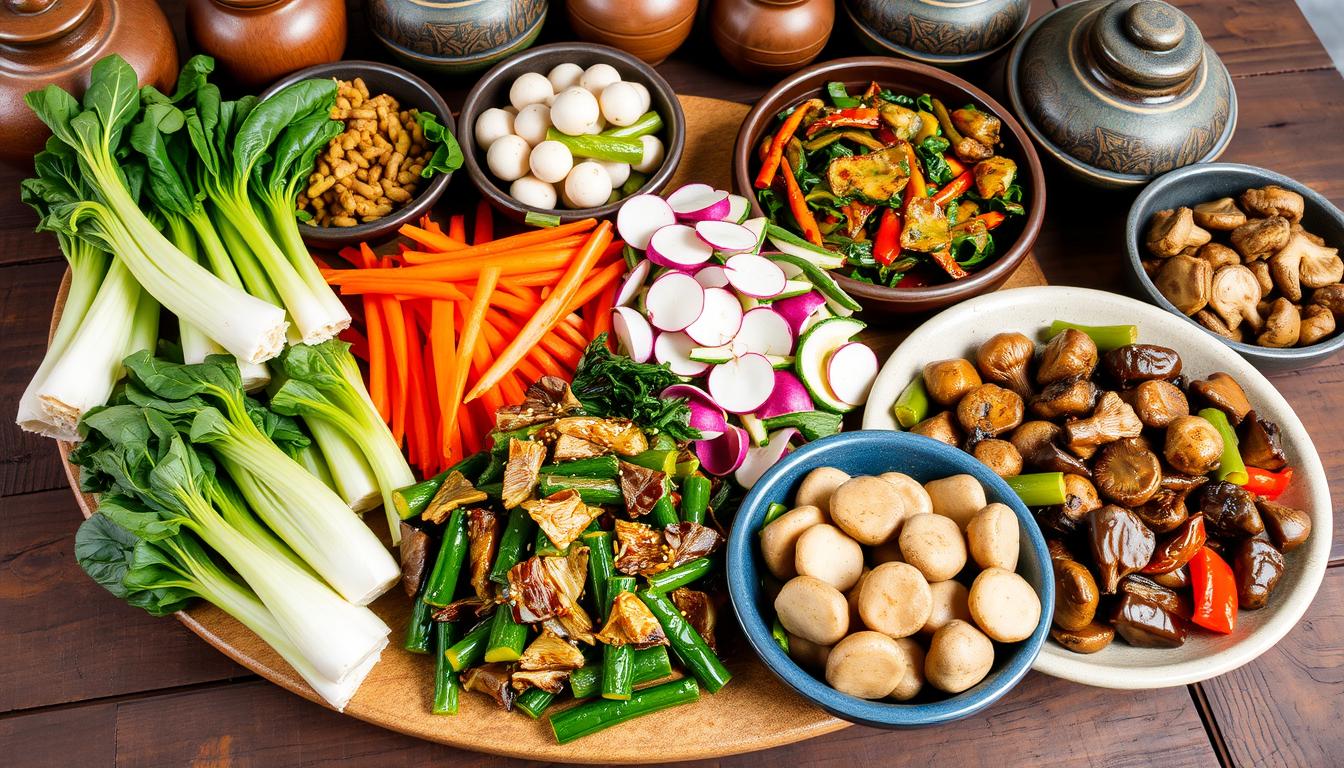Exploring Korean vegetable dishes is a journey to nourish your body and mind. Growing up in a Korean-American home, I loved the variety of plant-based side dishes. These dishes were not just food; they connected us to Korea’s rich culinary traditions.
These recipes are great for anyone looking to eat more plant-based foods. Korean cuisine often uses grains, legumes, and vegetables because meat was rare. Korean temple cuisine is all plant-based, using fresh ingredients from temple gardens or nearby fields. Many Korean dishes are already vegan or can be easily made so.
Table of Contents
Introduction to Korean Vegetable Dishes
Korean cuisine is famous for its focus on plants. It has a wide range of vegetable dishes that highlight the country’s cooking traditions. In the past, the availability of ingredients shaped Korean cooking, with a focus on grains, legumes, and seasonal produce.
This plant-based focus is clear in Korean temple cuisine. It’s all vegan, using ingredients from temple gardens or nearby fields and mountains.
Traditional Korean Cuisine: Plant-Based and Nourishing
Many classic Korean dishes are vegan or vegetarian. They can also be made to fit plant-based diets. These korean vegetable dishes offer a wide range of tastes, from the tangy korean kimchi to the sweet-savory korean japchae.
The variety of korean vegetable flavors in these dishes shows the creativity of Korean cooks. They have mastered turning plant-based ingredients into tasty and healthy meals.
Variety and Flavors of Korean Vegetable Dishes
The world of korean vegetable dishes is vast and exciting. It includes everything from korean temple cuisine to simple yet tasty korean plant-based dishes. Whether you love the fermented taste of korean kimchi or the sweet-savory mix of korean japchae, there’s a lot to explore.
This journey through korean vegetable dishes celebrates nature’s gifts and the talent of Korean chefs. It’s a true culinary adventure.
« Korean cuisine has long been recognized for its plant-based focus, with a rich tradition of vegetable-centric dishes that showcase the country’s culinary ingenuity and reverence for nature’s bounty. »
Essential Korean Vegetable Side Dishes
Korean cuisine is famous for its variety of vegetable side dishes, called banchan. These small dishes are key to the meal, adding flavor and texture to the main courses.
Kimchi: The Quintessential Fermented Vegetable
The star of Korean korean vegetable side dishes is korean kimchi. It’s a fermented dish made from cabbage, radish, or other veggies. Kimchi is spicy, sour, and umami, making it a hit with everyone.
Namul: Sautéed or Blanched Leafy Greens
Korean namul includes korean sauteed greens and korean blanched greens. These greens are cooked lightly to keep their taste and nutrients. You’ll find spinach, watercress, and bean sprouts, seasoned with garlic, sesame oil, and soy sauce.
The variety of korean vegetable side dishes in Korean cuisine is amazing. They offer a mix of flavors, textures, and health benefits. This makes them a favorite part of any meal.
« Korean cuisine is a symphony of flavors, with the banchan playing a vital role in creating a well-rounded and satisfying dining experience. »
Korean Vegetable Stir-Fries and Stews
Korean cuisine is known for its tasty vegetable stir-fries and stews. A favorite is japchae. It’s a mix of sweet potato noodles and colorful veggies.
Japchae: Sweet Potato Noodles with Vibrant Vegetables
Japchae is a beloved Korean dish. It combines chewy glass noodles with fresh veggies. This mix of flavors and textures makes it a comforting meal.
To make korean japchae, noodles are stir-fried with korean vegetable stir fries. These include carrots, spinach, mushrooms, and onions. A sweet soy sauce marinade adds flavor to the korean sweet potato noodles.
Japchae can be a side dish or a main course. It’s loved by many for its vibrant colors and textures. It’s a great addition to any korean vegetable stew or korean vegetable dishes spread.
« Japchae is a delightful and nutritious Korean dish that showcases the country’s culinary artistry. The sweet potato noodles and vibrant vegetables create a harmonious blend of flavors and textures that is sure to delight. »
Korean Vegetable Pancakes and Wraps
Korean cuisine offers a variety of vegetable-based pancakes and wraps. These dishes are both healthy and tasty. A standout is buchimgae, the savory Korean vegetable pancake.
Buchimgae: Savory Vegetable Pancakes
Buchimgae are korean vegetable pancakes made with vegetables, scallions, and seasonings. They are pan-fried until they are crisp and golden. You can enjoy them as a side dish, snack, or light meal.
The batter for these pancakes includes flour, cornstarch, salt, cold water, or milk. This mix creates a light and crispy texture. Carrots, cabbage, onions, and mushrooms are common ingredients, adding color and flavor.
Korean cuisine also has korean vegetable wraps with fresh veggies. These wraps use rice paper or leaves. They offer a mix of crunchy, flavorful ingredients in a convenient, hand-held format.
Whether you prefer korean vegetable pancakes or korean vegetable wraps, these dishes are a treat. They will delight your taste buds and nourish your body.

Korean Vegetable Dishes: A Nutritious Delight
Korean cuisine is famous for its tasty and healthy vegetable dishes. From kimchi to japchae, these dishes are great for adding more korean vegetable dishes, korean plant-based dishes, korean healthy recipes, and korean nutritious meals to your meals.
Korean cooking uses many vegetables, grains, and legumes. This makes these dishes full of vitamins, minerals, and fiber. Japchae is a favorite, especially during special times like Lunar New Year. It can be made with beef or without meat, showing how versatile these korean healthy recipes are.
Korean food has many korean nutritious meals that highlight korean plant-based dishes. Andong jjimdak and Galbitang use Korean glass noodles. Buchimgae and kongbap show the variety of korean vegetable dishes.
Adding more korean healthy recipes to your meals can be exciting. You’ll discover the rich flavors and nutrition in these korean plant-based dishes. They’re perfect for a side dish or a full vegetarian meal.
Korean Fermented Vegetable Dishes
Fermented vegetable dishes are key in Korean cuisine. They add flavor and health benefits to meals. Dongchimi and oiji are two examples that show Korean cooking’s creativity and variety.
Dongchimi: Radish Water Kimchi
Dongchimi is a tangy radish water kimchi loved in Korea’s cold months. It’s radish slices in a brine that’s full of probiotics. This mix of salty, sour, and sweet tastes is refreshing and appetizing.
Oiji: Pickled Cucumbers
Oiji, or Korean pickled cucumbers, are crunchy and flavorful. They’re cucumbers pickled in a brine, giving them a sour and salty taste. Their bright green color and firm texture make them a favorite side dish.
Dongchimi and oiji show how Korean fermented vegetable dishes improve meals and health. They’re full of probiotics, which help digestion and the immune system. They’re a tasty and healthy part of any Korean meal.
Korean Vegetable Soups and Stews
Korean cuisine is famous for its hearty vegetable soups and stews. Kongbap, a soybean sprout soup, is a standout. It’s a delicious and nutritious dish that shows off Korea’s plant-based cooking.
Kongbap: Soybean Sprout Soup
Kongbap, also called kongbap-guk, is a favorite korean soybean sprout soup. It’s a great example of korean vegetable soups and korean vegetable stews. It has tender soybean sprouts in a savory broth, with various vegetables and seasonings.
The secret to good kongbap is choosing and preparing the soybean sprouts right. These sprouts are crunchy and slightly sweet. They mix well with the aromatic broth, making the soup rich and comforting.
Kongbap is a main dish, often with steamed rice and korean vegetable side dishes, or banchan. This meal is a perfect mix of flavors and textures. It’s a favorite in many korean kongbap and korean soybean sprout soup lovers’ homes.
If you’re looking for a warm meal or want to try Korean cuisine, korean vegetable soups and korean vegetable stews like kongbap are great. They will please your taste buds and nourish your body. Explore Korean cooking and see how vegetables can become culinary wonders.
Korean Temple Cuisine: Vegan Delicacies
Dive into the world of Korean temple cuisine. It’s a mix of plant-based foods and Buddhist traditions. For over 1,600 years, Korean Buddhists have followed a vegan/vegetarian lifestyle. This is seen in the amazing Korean temple food they make.
Korean temple cuisine is mostly vegan. It avoids meat and animal products. Instead, it uses locally grown, seasonal ingredients. The dishes have a perfect balance of flavors, from earthy to spicy.
The heart of this tradition is respecting nature. Korean temples get their ingredients from their gardens or nearby fields. This ensures the food is fresh and sustainable.
« Korean temple cuisine embodies a commitment to purity, healthiness, and respect for natural flavors, making it popular among food enthusiasts. »
This plant-based culinary art is good for your body and soul. Places like Balwoogongyang in Seoul offer amazing Korean-style temple food. Even Buddhist temples across the country offer temple food at low or no cost.

If you love food or want a healthy, plant-based culinary adventure, try Korean temple cuisine. It will change how you see food, culture, and well-being.
Healthy Twists on Classic Korean Dishes
Many traditional Korean dishes can be made healthier and more plant-based. This is done without losing their authentic flavors. Two favorites that work well for this are bibimbap and japchae.
Bibimbap: Mixed Rice Bowl with Vegetables
The classic korean bibimbap is a colorful mixed rice bowl. It’s filled with sautéed and seasoned vegetables. To make it healthier, skip the raw egg or meat and add more veggies.
Try sautéed spinach, carrots, bean sprouts, mushrooms, and more. Season them with gochujang (Korean chili paste) dressing. This way, you get a nutritious and tasty korean healthy recipes option.
Japchae: Sweet Potato Noodles with Vegetables
Korean japchae is another dish that can be made healthier. It has sweet potato noodles and a mix of vegetables. For a better version, use more veggies like carrots, spinach, mushrooms, and onions.
By cutting down or removing meat, you make a tasty korean plant-based classics version. This way, you enjoy Korean flavors while eating more plants.
These healthier versions of korean vegetable dishes let you enjoy Korean cuisine’s true tastes. You also get to eat more plant-based foods.
Korean Vegetable Recipes for Every Occasion
Korean vegetable dishes are great for any meal. They can be side dishes, appetizers, or the main event. From kimchi to japchae, these dishes offer a wide range of flavors and textures.
Looking to try new korean vegetable recipes? Or want to enjoy the unique tastes of Korean food? These vegetable dishes are both healthy and tasty. They range from hearty korean side dishes to tasty korean appetizers and filling korean main dishes.
For special events, try tteokguk (rice cake soup) for Seollal or songpyeon (half-moon rice cakes) for Chuseok. Impress your guests with jeon (savory pancakes) or galbijjim (braised short ribs) at a party. For a comforting meal, enjoy bibimbap (mixed rice bowl) or the light flavors of miyeokguk (seaweed soup).
Discover the rich world of korean vegetable recipes. Learn about the unique flavors and traditions of Korean cuisine. Whether you’re an experienced cook or just starting out, these dishes will delight your taste buds and add a touch of Korean culture to your meals.
« Korean cuisine is a harmonious blend of tradition and innovation, where vegetables take center stage and nourish both body and soul. »
Conclusion
Korean vegetable dishes are a tasty and healthy way to enjoy Korean cuisine. They range from the tangy kimchi to the sweet japchae. These plant-based dishes highlight the rich flavors of Korean cooking.
Adding these Korean vegetable dishes to your meals brings authentic Korean tastes to your table. They also help you eat healthier and feel better.
If you love Korean food or are just starting, you’ll find Korean vegetable dishes exciting. They use fresh ingredients and healthy cooking methods. This makes them a great choice for those who want to eat well.
The love for Korean cuisine is growing everywhere. People are loving its plant-based and healthy aspects more and more. By trying different Korean vegetable dishes, you can enjoy great flavors and support your health.

